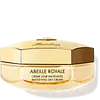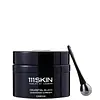What's inside
What's inside
 Key Ingredients
Key Ingredients

 Benefits
Benefits

 Concerns
Concerns

 Ingredients Side-by-side
Ingredients Side-by-side

Water
Skin ConditioningGlycerin
HumectantPropanediol
SolventC15-19 Alkane
SolventIsononyl Isononanoate
EmollientMel
EmollientJojoba Esters
EmollientGlyceryl Stearate
EmollientPEG-100 Stearate
Cellulose
AbsorbentAmmonium Acryloyldimethyltaurate/Vp Copolymer
Cetyl Alcohol
EmollientDimethicone
EmollientStearyl Alcohol
EmollientRoyal Jelly
Phenoxyethanol
PreservativeAscorbyl Glucoside
AntioxidantCaprylyl Glycol
EmollientSteareth-21
CleansingParfum
MaskingButyrospermum Parkii Butter
Skin ConditioningAcrylates/C10-30 Alkyl Acrylate Crosspolymer
Emulsion StabilisingAvena Sativa Kernel Extract
AbrasiveTocopheryl Acetate
AntioxidantXanthan Gum
EmulsifyingSodium Hydroxide
BufferingTetrasodium EDTA
Glyceryl Polymethacrylate
Centella Asiatica Leaf Extract
Skin ConditioningSodium Hyaluronate
HumectantGlycyrrhiza Glabra Root Extract
BleachingPEG-8
HumectantTocopherol
AntioxidantSodium Benzoate
MaskingHyaluronic Acid
HumectantButylene Glycol
HumectantSodium Lactate
BufferingZingiber Officinale Root Extract
MaskingBHT
AntioxidantPalmitoyl Hexapeptide-12
Skin ConditioningCitric Acid
BufferingWater, Glycerin, Propanediol, C15-19 Alkane, Isononyl Isononanoate, Mel, Jojoba Esters, Glyceryl Stearate, PEG-100 Stearate, Cellulose, Ammonium Acryloyldimethyltaurate/Vp Copolymer, Cetyl Alcohol, Dimethicone, Stearyl Alcohol, Royal Jelly, Phenoxyethanol, Ascorbyl Glucoside, Caprylyl Glycol, Steareth-21, Parfum, Butyrospermum Parkii Butter, Acrylates/C10-30 Alkyl Acrylate Crosspolymer, Avena Sativa Kernel Extract, Tocopheryl Acetate, Xanthan Gum, Sodium Hydroxide, Tetrasodium EDTA, Glyceryl Polymethacrylate, Centella Asiatica Leaf Extract, Sodium Hyaluronate, Glycyrrhiza Glabra Root Extract, PEG-8, Tocopherol, Sodium Benzoate, Hyaluronic Acid, Butylene Glycol, Sodium Lactate, Zingiber Officinale Root Extract, BHT, Palmitoyl Hexapeptide-12, Citric Acid
Water
Skin ConditioningIsopropyl Myristate
EmollientHydrogenated Palm Oil
EmollientCetearyl Alcohol
EmollientCaprylic/Capric Triglyceride
MaskingGlyceryl Stearate Se
EmulsifyingGlycerin
HumectantGlyceryl Stearate
EmollientPEG-100 Stearate
Benzyl Alcohol
PerfumingCeteareth-25
CleansingPEG-7 Hydrogenated Castor Oil
EmulsifyingZinc Oxide
Cosmetic ColorantSodium Hyaluronate
HumectantAesculus Hippocastanum Seed Extract
Skin ConditioningSodium Ascorbyl Phosphate
AntioxidantAcetyl Cysteine
AntioxidantMaltodextrin
AbsorbentSilica
AbrasiveGlycyrrhiza Glabra Root Extract
BleachingCentella Asiatica Extract
CleansingPrunus Armeniaca Kernel Oil
MaskingPolysorbate 20
EmulsifyingPEG-20 Glyceryl Laurate
EmulsifyingTocopherol
AntioxidantLinoleic Acid
CleansingRetinyl Palmitate
Skin ConditioningDiamond Powder
AbrasiveXanthan Gum
EmulsifyingPhenoxyethanol
PreservativeEthylhexylglycerin
Skin ConditioningDiethylhexyl Syringylidenemalonate
Skin ProtectingCitric Acid
BufferingParfum
MaskingWater, Isopropyl Myristate, Hydrogenated Palm Oil, Cetearyl Alcohol, Caprylic/Capric Triglyceride, Glyceryl Stearate Se, Glycerin, Glyceryl Stearate, PEG-100 Stearate, Benzyl Alcohol, Ceteareth-25, PEG-7 Hydrogenated Castor Oil, Zinc Oxide, Sodium Hyaluronate, Aesculus Hippocastanum Seed Extract, Sodium Ascorbyl Phosphate, Acetyl Cysteine, Maltodextrin, Silica, Glycyrrhiza Glabra Root Extract, Centella Asiatica Extract, Prunus Armeniaca Kernel Oil, Polysorbate 20, PEG-20 Glyceryl Laurate, Tocopherol, Linoleic Acid, Retinyl Palmitate, Diamond Powder, Xanthan Gum, Phenoxyethanol, Ethylhexylglycerin, Diethylhexyl Syringylidenemalonate, Citric Acid, Parfum
Ingredients Explained
These ingredients are found in both products.
Ingredients higher up in an ingredient list are typically present in a larger amount.
Citric Acid is an alpha hydroxy acid (AHA) naturally found in citrus fruits like oranges, lemons, and limes.
Like other AHAs, citric acid can exfoliate skin by breaking down the bonds that hold dead skin cells together. This helps reveal smoother and brighter skin underneath.
However, this exfoliating effect only happens at high concentrations (20%) which can be hard to find in cosmetic products.
Due to this, citric acid is usually included in small amounts as a pH adjuster. This helps keep products slightly more acidic and compatible with skin's natural pH.
In skincare formulas, citric acid can:
While it can provide some skin benefits, research shows lactic acid and glycolic acid are generally more effective and less irritating exfoliants.
Most citric acid used in skincare today is made by fermenting sugars (usually from molasses). This synthetic version is identical to the natural citrus form but easier to stabilize and use in formulations.
Read more about some other popular AHA's here:
Learn more about Citric AcidGlycerin is already naturally found in your skin. It helps moisturize and protect your skin.
A study from 2016 found glycerin to be more effective as a humectant than AHAs and hyaluronic acid.
As a humectant, it helps the skin stay hydrated by pulling moisture to your skin. The low molecular weight of glycerin allows it to pull moisture into the deeper layers of your skin.
Hydrated skin improves your skin barrier; Your skin barrier helps protect against irritants and bacteria.
Glycerin has also been found to have antimicrobial and antiviral properties. Due to these properties, glycerin is often used in wound and burn treatments.
In cosmetics, glycerin is usually derived from plants such as soybean or palm. However, it can also be sourced from animals, such as tallow or animal fat.
This ingredient is organic, colorless, odorless, and non-toxic.
Glycerin is the name for this ingredient in American English. British English uses Glycerol/Glycerine.
Learn more about GlycerinGlyceryl Stearate is a mix of glycerin and stearic acid.
It is used to stabilize the mixing of water and oil ingredients. By preventing these ingredients from separating, it can help elongate shelf life. It can also help thicken the product's texture.
As an emollient, it helps soften skin and supports barrier-replenishing ingredients.
In cosmetics, Glyceryl Stearate is often made from vegetable oils or synthetically produced.
This ingredient may not be fungal-acne safe
Fun fact: The human body also creates Glyceryl Stearate naturally.
Learn more about Glyceryl StearateGlycyrrhiza Glabra Root Extract is an extract of the roots of Licorice. It has been found to have several benefits such as skin hydrating, conditioning, and soothing.
One component, glabridin, has extra potent antioxidant and soothing properties. It has also been found to block pigmentation from UVB rays in guinea pigs.
Licorice Root also contains a flavonoid. Flavonoids are a natural substance from in plants. Flavonoids also have antioxidant properties.
Another component, glycyrrhizin, has been found to have anti-inflammatory and antimicrobial benefits. This may make licorice root extract effective at treating acne. However, more research is needed to support this.
Liquiritin is one of the flavone compounds found in licorice. It has been found to help lighten skin by preventing tyrosinase from reacting with tyrosine. When the two react, protein is converted to melanin. Melanin is the substance in your body that gives your features pigmentation.
Learn more about Glycyrrhiza Glabra Root ExtractParfum is a catch-all term for an ingredient or more that is used to give a scent to products.
Also called "fragrance", this ingredient can be a blend of hundreds of chemicals or plant oils. This means every product with "fragrance" or "parfum" in the ingredients list is a different mixture.
For instance, Habanolide is a proprietary trade name for a specific aroma chemical. When used as a fragrance ingredient in cosmetics, most aroma chemicals fall under the broad labeling category of “FRAGRANCE” or “PARFUM” according to EU and US regulations.
The term 'parfum' or 'fragrance' is not regulated in many countries. In many cases, it is up to the brand to define this term.
For instance, many brands choose to label themselves as "fragrance-free" because they are not using synthetic fragrances. However, their products may still contain ingredients such as essential oils that are considered a fragrance by INCI standards.
One example is Calendula flower extract. Calendula is an essential oil that still imparts a scent or 'fragrance'.
Depending on the blend, the ingredients in the mixture can cause allergies and sensitivities on the skin. Some ingredients that are known EU allergens include linalool and citronellol.
Parfum can also be used to mask or cover an unpleasant scent.
The bottom line is: not all fragrances/parfum/ingredients are created equally. If you are worried about fragrances, we recommend taking a closer look at an ingredient. And of course, we always recommend speaking with a professional.
Learn more about ParfumPeg-100 Stearate is an emollient and emulsifier. As an emollient, it helps keep skin soft by trapping moisture in. On the other hand, emulsifiers help prevent oil and water from separating in a product.
PEGS are a hydrophilic polyether compound . There are 100 ethylene oxide monomers in Peg-100 Stearate. Peg-100 Stearate is polyethylene glycol ester of stearic acid.
Phenoxyethanol is a preservative that has germicide, antimicrobial, and aromatic properties. Studies show that phenoxyethanol can prevent microbial growth. By itself, it has a scent that is similar to that of a rose.
It's often used in formulations along with Caprylyl Glycol to preserve the shelf life of products.
Sodium Hyaluronate is hyaluronic acid's salt form. It is commonly derived from the sodium salt of hyaluronic acid.
Like hyaluronic acid, it is great at holding water and acts as a humectant. This makes it a great skin hydrating ingredient.
Sodium Hyaluronate is naturally occurring in our bodies and is mostly found in eye fluid and joints.
These are some other common types of Hyaluronic Acid:
Learn more about Sodium HyaluronateTocopherol (also known as Vitamin E) is a common antioxidant used to help protect the skin from free-radicals and strengthen the skin barrier. It's also fat soluble - this means our skin is great at absorbing it.
Vitamin E also helps keep your natural skin lipids healthy. Your lipid skin barrier naturally consists of lipids, ceramides, and fatty acids. Vitamin E offers extra protection for your skin’s lipid barrier, keeping your skin healthy and nourished.
Another benefit is a bit of UV protection. Vitamin E helps reduce the damage caused by UVB rays. (It should not replace your sunscreen). Combining it with Vitamin C can decrease sunburned cells and hyperpigmentation after UV exposure.
You might have noticed Vitamin E + C often paired together. This is because it is great at stabilizing Vitamin C. Using the two together helps increase the effectiveness of both ingredients.
There are often claims that Vitamin E can reduce/prevent scarring, but these claims haven't been confirmed by scientific research.
Learn more about TocopherolWater. It's the most common cosmetic ingredient of all. You'll usually see it at the top of ingredient lists, meaning that it makes up the largest part of the product.
So why is it so popular? Water most often acts as a solvent - this means that it helps dissolve other ingredients into the formulation.
You'll also recognize water as that liquid we all need to stay alive. If you see this, drink a glass of water. Stay hydrated!
Learn more about WaterXanthan gum is used as a stabilizer and thickener within cosmetic products. It helps give products a sticky, thick feeling - preventing them from being too runny.
On the technical side of things, xanthan gum is a polysaccharide - a combination consisting of multiple sugar molecules bonded together.
Xanthan gum is a pretty common and great ingredient. It is a natural, non-toxic, non-irritating ingredient that is also commonly used in food products.
Learn more about Xanthan Gum